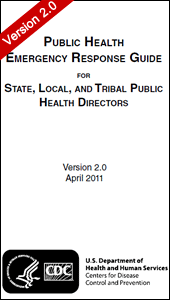Public Health Emergency Response Guide for State, Local, and Tribal Public Health Directors - Version 2.0
State, local, and Tribal health departments play a crucial role in preparing for, responding to, and recovering from emergencies and disasters of all kinds.
 Download the entire Response Guide (print on 8.5" x 11" paper)
Download the entire Response Guide (print on 8.5" x 11" paper)
English [PDF - 216 KB] Version 2.0
Spanish [PDF - 289 KB] Version 2.0
Purpose of the Public Health Emergency Response Guide
Health department staff need readily accessible information and guidance to:
- Prepare and train public health professionals,
- Establish priorities in disaster responses, and
- Act quickly and efficiently in emergencies and disasters.
Public Health Roles and Responsibilities in Emergencies and Disasters
The Public Health Emergency Response Guide is a valuable resource for public health professionals who have the following roles and responsibilities:
- Initiating the public health response during the first 24 hours (i.e., the acute phase) of an emergency or disaster.
- Coordinating with the existing emergency response structures in specific types of incidents, such as floods, earthquakes, and acts of terrorism.
Information in the guide is consistent with the doctrine, concepts, principles, terminology, and organizational processes in the National Response Framework (NRF) and the National Incident Management System (NIMS).
The guide is not a:
- substitute for emergency preparedness activities
- replacement for existing emergency operations plans, procedures, or guidelines within a local, state, or Tribal health department.
For More Information
NCEH encourages users to provide feedback on the utility and effectiveness of the guide in incidents and exercises, as well as in training and education programs.
To receive a copy of the Public Health Emergency Response Guide for State, Local, and Tribal Public Health Directors, provide feedback, or request more information, please send an e-mail to pherg@cdc.gov.
- Page last reviewed: May 10, 2017
- Page last updated: May 15, 2017
- Content source:
- Maintained By:


 ShareCompartir
ShareCompartir